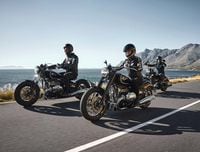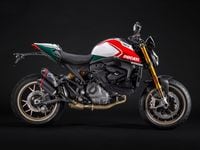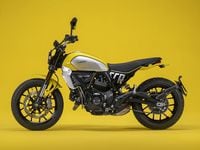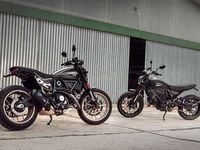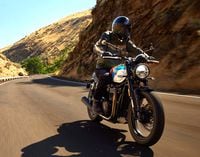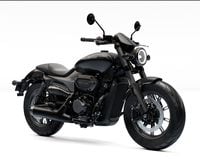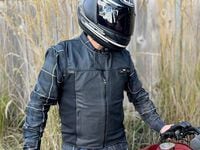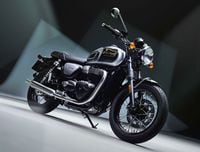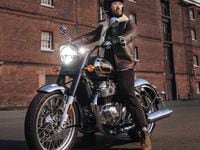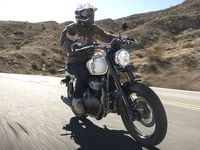It seemed fitting that the first 100th-anniversary Harley-Davidson model we sampled should be the Electra Glide, perhaps the most traditional of all Harley's models. The "Glide" part goes back to 1949, when Harley first introduced a hydraulically damped fork, the Hydra-Glide, on its big twins. The name was applied to the entire bike in 1958, when the Duo-Glide was rolled out with rear suspension. In 1965, when the big twin got much needed electric starting, it was renamed the Electra Glide. For six years, until the Super Glide, the first true factory cruiser, debuted out in 1971, the Electra Glide was the only Harley big twin. It was the bike that you thought of when someone said "Harley," "dresser," "big twin" or even "American motorcycle."
Though it was regarded as the first full-dress touring bike, the Electra Glide didn't come with all the current equipment back in the 1960s. The owner could order all the accessories to dress it, but even then, because wind protection was provided by a windshield rather than a real fairing and there was no trunk, it resembled today's Road King more than the Electra Glide we test here. That has certainly changed over the decades. Our test bike was the Electra Glide Ultra Classic, which means that in addition the saddlebags, trunk (called a King Tour-Pak in Harley-speak), and fork-mounted "batwing" fairing with lowers (as opposed to the fuller frame-mounted fairing without lowers found on the Road Glide), it is equipped with a full complement of bells and whistles. That includes spotlights, cruise control and an audio system. The audio package includes an AM/FM/weatherband radio and, for 2003, a CD player. It delivers sound through four speakers (two in the fairing, and two at the front of the trunk) or optional helmet-mounted headsets. The Ultra Classic includes a CB radio and intercom, which are not available on the one-step-down Electra Glide Classic, which also lacks the fairing lowers with their storage compartments.
That's not the only thing that has changed about the Electra Glide in 38 years. Every part on the basic bike is also different, often radically so. However, Harley, ever mindful of tradition, has kept the basic layout and appearance close enough to the original that the family resemblance is unmistakable. Consider the engine. Back when the Electra Glide was first made public, it was powered by an air-cooled 45-degree V-twin with a single carb and two overhead valves per cylinder operated by pushrods and hydraulic lifters. You can describe some current Electra Glide engines exactly the same way, although the Ultra Classic is only available with electronic fuel injection. Even if the basic layout of the engine is the same, the current Twin Cam 88 shares virtually nothing else with its ancestors. Nor does it work like them. The current 1450cc engine has more displacement, is much more reliable, and makes substantially more power over a broader rpm range than any of the earlier Harley big twin engines. Though the previous generation engine, the Evolution, had power that was adequate for a touring bike, previous motors were marginal. The current TC88-powered Electra Glide is the first that really feels strong, even when fully loaded.
The entire drivetrain has undergone an evolutionary improvement as well. The current powertrain is state-of-the-art, which couldn't be said of earlier examples. Some might argue that other big cruiser V-twins boast features like four valves per cylinder, overhead cams and other technical advancements, but those bikes all get poorer fuel mileage and, except for the 1800cc Honda VTX, make less power despite more displacement. The fuel-injected version of Harley's big twin starts readily with no need for choke and idles immediately. It pulls without pause from about 2000 rpm to redline. Throttle response is even and predictable. Like other big twins, you can feel the heft of the gearbox components when you shift the Harley, but it actually shifts more positively than some others. It has little lash in the driveline, and the belt final drive is reliable, quiet and needs little maintenance. In fact, our only complaint about the driveline concerns the clutch, which requires a strong pull and is a somewhat abrupt in the last part of its engagement cycle.
Harley has a counterbalanced version of the TC88 engine, but that engine is not used in the touring series machines, which rely instead on rubber mounts to damp out the motor's shaking. We would kind of like to see Harley use both the rubber mounts and the counterbalancers in the touring models, but we can't say that this machine has any vibration issues, though there is a pleasant shake and some engine speeds at or near idle. At highway speeds, no vibration reaches you unless you touch something attached directly to the engine. The suspension, which is air-assisted in the back also does a respectable job of keeping the shakes and thumps away. We started out with about 70 psi if air pressure, which was on the stiff side for a single rider with a full load of luggage. About 20 psi seemed to be ideal with just the rider.
Since we'd recently spent some time on the Road Glide, which has the same chassis but with a more aerodynamic frame-mounted fairing without spotlights or the trunk and accompanying audio equipment mounted on it, we instantly made comparisons. The standard windshield on the Electra Glide is much taller than the short item on the Road Glide. This bike's shield is too tall for an average rider to see over without stretching hard, which we consider to be a safety problem, certainly in the rain. On the other hand the Road Glide's is perhaps too short, because the rider's helmet is in the buffet zone. The batwing fairing of the E-Glide has clear-plastic wind deflectors mounted on its lower edge which can be quickly removed and stowed during hot weather. You can also take off the lowers if you want more cooling wind, but you have to leave them (and their small but handy storage compartments) at home if you do. Riding in 90-degree temps, we were glad to have the deflectors gone. A fair amount of engine heat reaches you at low speeds.
The higher windscreen also gives the Electra Glide stereo's sound a better run at your ears, making it more audible at high speeds, though it remains far from the sound quality you get in a typical car, even with the windows down. Harley's latest audio system is the first to include a CD player as standard equipment. The CD player is right in the dash. The most-used audio controls are located below the standard handlebar switches and are easy to use after a little practice. The controls for the smooth-working cruise control are in the same area.
The Electra Glide puts your butt slightly closer to the handlebar grips, which sits you bolt upright, whereas the Road Glide cants you slightly forward. Both work for us and, even though the seats are different, both leave us wishing for somewhat better padded saddles after two or three hours aboard. The Road Glide saddle was slightly better. Of course, passengers prefer the Electra Glide by far because the trunk includes a passenger backrest as well as the speakers. You can mount a trunk on the Road Glide, of course, effectively recreating the defunct Tour Glide in modern form.
Both bikes use the same bags, which are the same as those on other Harleys with hard bags. They are lockable, easy to open or latch with one hand, weatherproof, and of medium-to-large capacity. They are also easy to remove when you are cleaning the bike or need access to the rear wheel. The Ultra includes sturdy removable liner bags. The trunk is roomy, and the fact that it is hinged on the lefty side means that you can open it even with something on the passenger saddle and that you don't have to turn your back on traffic while getting into it at roadside.
With similar amounts of luggage, the Road Glide felt just slightly more stable than the Electra Glide, though we have no complaints about the Electra Glide's handling. We attribute the Road Glide's advantage to either its lack of a trunk or its fairing design. The Electra Glide steers precisely and predictably, but the Roadie steers just bit more so, probably because there is no trunk at the other end of the bike. Both have satisfactory suspension control and good cornering clearance.
Harley brakes get a workout when they have to stop a big heavily loaded dresser. Though they are up to the job, a strong pull is required to get full power from the front brake. You also need at least average-sized hands to easily reach the lever, which is not adjustable.
Except for a burned-out spotlight, our Electra Glide Ultra Classic FLHTCUI was trouble-free for the more than 2000 miles we rode it. Fuel consumption was higher than we expected, with the Electra Glide averaging just 37.8 mpg. The fuel light would typically come on between 150 and 170 miles after topping up to the very rim. The Road Glide we rode under similar conditions averaged about 50 mpg, and again we attribute the difference to better aerodynamics from the Road Glide's fairing.
With the TC88 engine, the Electra Glide can finally hold its own with other traditionally styled touring machines. Though it doesn't work as well overall as the Honda Gold Wing and there are mixed verdicts when we compare it to BMW's touring machines, not everyone wants those other bikes' plastic-wrapped lines. We also prefer the Harley to the Yamaha Venture, the other touring bike with traditional styling, though the Harley is substantially more expensive. With the least-expensive paint option, the Ultra Classic lists for exactly $20,000 with freight. However, if you are getting a 100th anniversary model (all 2003s have engine and tank badges and other paraphernalia announcing the fact), you really should get the silver and black paint scheme, which adds another $1300 to the price. If you'd like to save some money, buy the Electra Glide Classic (FLHTC) for $3000 less.
The good news is that in many parts of the country, you can now buy Harleys for list. We have even heard that some dealers are advertising big twins at below MSRP. With its increased production capacity, Harley finally seems to be able to more or less meet demand for the first time in almost two decades. We hope that this means that riders who have previously walked away from bikes like the Electra Glide, either because of the wait or the price premium, will finally start to see them as attainable. The is right because as it turns 38 and celebrates the family's 100th anniversary, we think the Electra Glide is in the prime of its life, enjoying the color of the past without being crippled by clinging to it. You can enjoy the flavor of that Electra Glide of 1965, but you don't have to actually ride it.










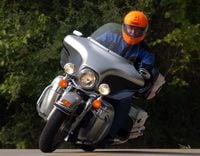
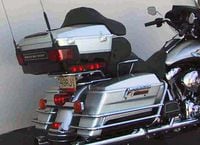
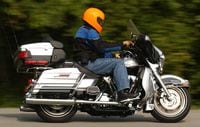
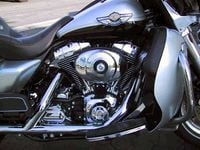
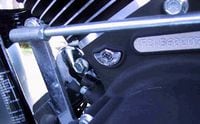
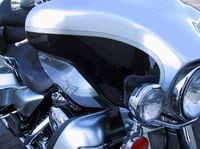
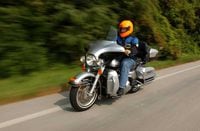
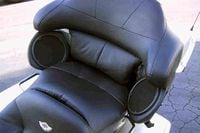
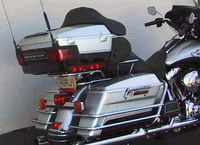
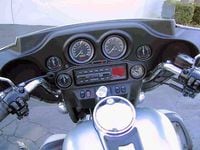
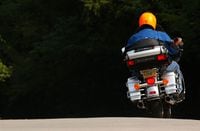
/cloudfront-us-east-1.images.arcpublishing.com/octane/H6Z2IC7WYRBXZNQS4MI3SZ5KPQ.jpg)
/cloudfront-us-east-1.images.arcpublishing.com/octane/IWO5T5PBT5E4HFQ5GK47H5YXR4.jpg)
/cloudfront-us-east-1.images.arcpublishing.com/octane/OQVCJOABCFC5NBEF2KIGRCV3XA.jpg)
/cloudfront-us-east-1.images.arcpublishing.com/octane/F3O2DGLA4ZBDJGNVV6T2IUTWK4.jpg)
/cloudfront-us-east-1.images.arcpublishing.com/octane/ZXYQE3MHLFDSPKNGWL7ER5WJ4U.jpg)
/cloudfront-us-east-1.images.arcpublishing.com/octane/RDF24VM7WVCOBPIR3V3R4KS63U.jpg)
/cloudfront-us-east-1.images.arcpublishing.com/octane/W7RSIBFISNHJLIJESSWTEBTZRQ.jpg)
/cloudfront-us-east-1.images.arcpublishing.com/octane/AERA26ENRNBW3K324YWCPEXYKM.jpg)
/cloudfront-us-east-1.images.arcpublishing.com/octane/YWX3YX7QBBHFXFDMEEEKRG4XJE.jpg)
/cloudfront-us-east-1.images.arcpublishing.com/octane/I7OKI53SZNDOBD2QPXV5VW4AR4.jpg)
/cloudfront-us-east-1.images.arcpublishing.com/octane/IH52EK3ZYZEDRD3HI3QAYOQOQY.jpg)
/cloudfront-us-east-1.images.arcpublishing.com/octane/K2FSAN7OWNAXRJBY32DMVINA44.jpg)
/cloudfront-us-east-1.images.arcpublishing.com/octane/G4XK7JL24FCUTKLZWUFVXOSOGE.jpg)
/cloudfront-us-east-1.images.arcpublishing.com/octane/JJNXVAC27ZCDDCMTHTQZTHO55Y.jpg)
